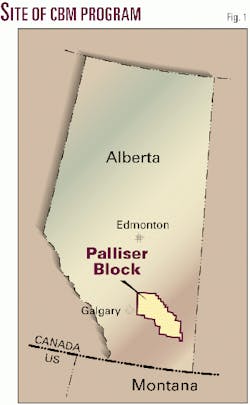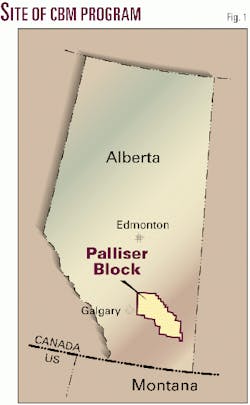A large coalbed methane exploration and development project is starting in the southeastern Alberta portion of the Western Canada Sedimentary basin.
Quicksilver Resources Inc., a Fort Worth independent that went public only 20 months ago, will join PanCanadian Petroleum Ltd. in the program.
Quicksilver has expertise in the Michigan basin with low-permeability gas-producing Devonian Antrim shale, which has similar geological and production characteristics to CBM. The company, Michigan's largest independent gas producer, grew from a private predecessor established in 1963.
Site of the effort is PanCanadian's Palliser block of almost 1 million acres that extends southeastward from Calgary.
Palliser is one of PanCanadian's three main Canadian domestic business units. PanCanadian describes the block as the company's "historical, current, and future foundation."
Palliser generated more than 40% of PanCanadian's hydrocarbon production in 1999 and by itself would have ranked among Canada's top 15 producers. This status is exclusive of CBM, and yet PanCanadian describes the block as "one of the largest potential CBM plays in North America."
Expanding relationship
PanCanadian and Quicksilver's Canadian Unit, MGV Energy Inc., Calgary, are expanding an existing relationship geared to acquire and develop shallow gas reserves in Alberta to focus on determining commercial CBM potential on PanCanadian lands.
An initial exploration phase is to start by yearend 2000 with the drilling of a series of test wells. Four pilot wells will follow each successful exploratory well.
MGV, with its unconventional gas expertise, will operate the exploration and pilot phases of the joint venture. The companies will share exploratory and evaluation costs.
About 1,400 of the 2,000 wells PanCanadian plans to have drilled this year will be shallow gas wells on the Palliser block. The year 2000 program includes no coalbed methane wells.
Palliser produced 638 MMcfd of gas and 27,200 b/d of oil and condensate in 1999, all of it conventional, from 1,303 wells. End-1999 reserves on the block were 465 MMboe. Capital spending at Palliser was $359 million in 1999.
Palliser produces mostly from Cretaceous aged formations at 300 m to 2,000 m. There has been no coalbed methane evaluation or production to date at Palliser.
PanCanadian received the land that makes up the Palliser business unit from the Canadian government early this century. The land was partial payment to PanCanadian's founding company, Canadian Pacific Ltd., for completing Canada's first transcontinental railway, the Canadian Pacific.
Quicksilver said the joint venture's existing acreage and infrastructure are key to the CBM play's economics.
The Canadian Gas Potential Committee, made up of volunteers with industry and government experience, has projected CBM as one of western Canada's largest sources of future gas. Resources on the PanCanadian-Quicksilver joint venture lands are included in its estimates.
CGPC estimated the resource at 273 tcf of CBM, compared with 188 tcf of conventional gas in western Canada and 107 tcf of conventional gas in Canadian frontier basins (OGJ, Dec. 15, 1997, p. 67).


